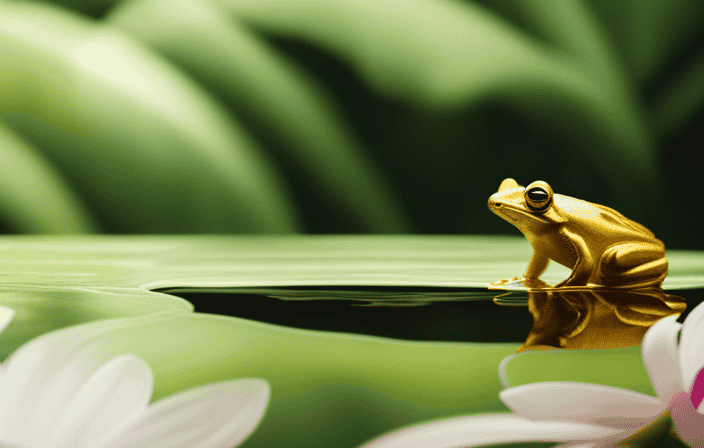Interestingly, these tiny amphibians carry significant symbolic weight across various cultures and traditions globally. From the civilizations of ancient Egypt to the Native American communities, frogs are celebrated as emblematic of fertility, change, and rejuvenation.
Their connection to rain, water, and cleansing rituals further highlights their significance in spiritual beliefs.
However, the decline in frog populations due to threats like chytridiomycosis reminds us of the delicate balance of ecosystems and the importance of conservation.
In this article, we explore the profound symbolism of frogs and the lessons they teach us about embracing change and resilience.
Key Takeaways
- Frogs are powerful symbols of fertility, transformation, and renewal in many cultures.
- They are associated with rain, water, and cleansing rituals in Native American and African cultures, and with creation, fertility, and childbirth in ancient Egypt.
- In Chinese culture, frogs are seen as a good luck sign representing wealth and Yin energy.
- Frogs play a significant role in Hinduism, representing the process of spiritual transformation and the cycle of life, death, and rebirth.
Symbolism in Different Cultures
I find it fascinating how frogs hold such powerful symbolism in different cultures. They represent fertility, transformation, and renewal. Frogs are also associated with rain, water, and cleansing rituals.
In African cultures, frogs are seen as symbols of change and transformation. They are believed to be messengers from the spirit world, bringing important messages and guiding individuals on their spiritual journey.
The ability of frogs to adapt to their environment and undergo metamorphosis from tadpoles to adult frogs is seen as a reflection of the cyclical nature of life and the need for personal growth and renewal.
The connection between frogs and water in African culture highlights their role in maintaining balance and harmony in the natural world.
Overall, the symbolism of frogs in various cultures underscores their profound spiritual significance and the valuable lessons they teach about embracing change and transformation.
Frog as a Symbol of Renewal
Representing renewal and transformation, frogs hold significant spiritual meaning in various cultures and traditions. Frog symbolism in spiritual growth is prevalent, as these amphibians embody the concept of change and personal evolution.
Frogs are often seen as messengers of change, guiding individuals on their spiritual journey towards self-discovery and enlightenment. Through their process of metamorphosis, frogs teach us the importance of embracing new experiences and opportunities for growth. They remind us that change is a natural part of life and should be embraced rather than feared.
As symbols of renewal, frogs encourage us to let go of what no longer serves us and to embrace the transformation that comes with it. By observing frog behavior and studying their symbolism, we can gain valuable insights into navigating life’s transitions and finding inner peace.
Frog in Native American Culture
In Native American culture, frogs hold deep spiritual significance, representing the connection between rain, water, and cleansing rituals. They are seen as powerful symbols of renewal and transformation. Native American tribes view frogs as guardians of water sources and believe that their presence brings rain and ensures the fertility of the land. The spiritual importance of frogs in Native American culture is reflected in their conservation efforts to protect these amphibians and their habitats. Frogs play a vital role in the environment as indicators of the health of ecosystems. Their decline in populations can have detrimental effects on the balance of ecosystems and biodiversity. Therefore, conservation efforts are crucial to preserve the important role that frogs play in maintaining the delicate equilibrium of the natural world.
Frog in Ancient Egyptian Mythology
The ancient Egyptians revered the frog-headed goddess Heket, who symbolized creation, fertility, and childbirth. In ancient Egyptian mythology, frogs played a significant role in the spiritual beliefs of the people.
Heket, often depicted with the head of a frog, was associated with the process of creation and the power of fertility. She was believed to protect newborn children and aid in the birthing process.
The Egyptians saw the frog as a symbol of life, death, and rebirth, closely tied to the cycles of nature. This spiritual significance of frogs in ancient Egyptian culture reflects their belief in the interconnectedness of all living beings.
Similarly, in Hinduism, frogs hold a symbolic role in representing the cycle of life, death, and rebirth, emphasizing the spiritual transformation that individuals can attain. Lord Vishnu’s connection to frogs highlights their importance in Hindu mythology as well.
Frog in Chinese Culture
I find it fascinating how Chinese culture sees frogs as a sign of good luck, representing wealth and Yin energy. In Chinese cultural significance, frogs are associated with prosperity and abundance. They are believed to bring financial success and attract wealth into one’s life.
The frog’s connection to Yin energy, which represents the feminine, passive, and receptive aspects of life, further enhances its symbolic meaning in Chinese culture.
Additionally, the frog’s role in Hindu mythology adds to its significance. In Hinduism, frogs are linked to the cycle of life, death, and rebirth. Lord Vishnu, one of the most important deities in Hinduism, takes the form of a golden frog, emphasizing the spiritual transformation and the path to attaining moksha (Nirvana).
The cultural significance of frogs in both Chinese and Hindu traditions showcases the universal recognition of their symbolic power as bringers of luck, wealth, and spiritual transformation.
Frog Dreams and Interpretation
Dreaming about frogs can offer valuable insights into personal growth, renewal, and the need for transformation. The symbolism of frogs in Hinduism adds a spiritual dimension to these dreams. In Hindu mythology, frogs are associated with the cycle of life, death, and rebirth. Lord Vishnu, a major deity in Hinduism, takes the form of a golden frog, Shatrupa, before his avatars. This signifies renunciation and the path to attaining moksha, or Nirvana. Therefore, when frogs appear in dreams, they may be interpreted as a message to embrace change, let go of attachments, and embark on a spiritual transformation. The table below provides a summary of the key symbolism associated with frog dreams in different cultures.
| Culture | Symbolism of Frog Dreams |
|---|---|
| Native American | Connection to water spirits and cleansing |
| Ancient Egypt | Protection of newborn children and fertility |
| Chinese | Good luck, wealth, and Yin energy |
| Hinduism | Spiritual transformation and the cycle of life, death, and rebirth |
Interpreting frog dreams requires paying attention to the context and details within the dream, as well as trusting one’s intuition for accurate interpretation. These dreams can guide individuals on their spiritual journey and offer messages about personal growth and embracing change.
Frog as a Symbol of Transformation
Embracing change and growth, frogs symbolize transformative experiences and offer valuable lessons in resilience and adaptability. In Native American culture, frogs hold deep symbolism. They are often associated with rain and water spirits, highlighting their connection to the natural world and the cyclical nature of life.
Frogs are seen as messengers of cleansing and renewal, guiding individuals on their spiritual journey. Frog dreams also carry profound spiritual meaning. They can signify personal growth, the need for transformation, or serve as warnings of danger. Paying attention to dream details and trusting our intuition can provide insights into these messages.
The spiritual meaning of frog dreams encourages introspection and embracing change for personal growth and enlightenment. By understanding the symbolism of frogs in Native American culture and the spiritual meaning of frog dreams, we can gain a deeper appreciation for the transformative power of these creatures.
Frog in Hinduism and Lord Vishnu
Lord Vishnu takes the form of a golden frog, Shatrupa, before his avatars, symbolizing the path to attaining moksha (Nirvana) and the process of spiritual transformation.
In Hinduism, frogs hold great symbolic significance. They are associated with the cycle of life, death, and rebirth, highlighting the concept of reincarnation. Lord Vishnu’s connection to frogs emphasizes their spiritual importance in Hindu mythology.
The frog’s transformation from the water to land symbolizes the journey of the soul from the material world to the spiritual realm. This transformation represents the process of spiritual growth and enlightenment in Hinduism.
The frog’s ability to adapt to different environments also reflects the importance of flexibility and resilience on the spiritual path.
By embodying the golden frog, Lord Vishnu teaches devotees the need for spiritual transformation and the ultimate goal of attaining liberation.
Threats to Frog Populations
Chytridiomycosis, a deadly fungus, poses a major threat to frog populations, causing amphibian extinction and alarming rates of decline, according to the World Health Organization. This devastating disease has had a significant impact on frog populations worldwide.
The decline in frog populations not only affects the frogs themselves, but also has far-reaching consequences for ecosystems and biodiversity. Frogs play an important role in maintaining the balance of their habitats, as they help control insect populations and serve as a food source for other species.
Conservation efforts are crucial in order to protect frogs and prevent further decline. Initiatives such as habitat restoration, captive breeding programs, and public awareness campaigns are being implemented to address this urgent issue.
By raising awareness and taking action, we can ensure the survival of these incredible creatures and preserve the delicate balance of our ecosystems.
Conservation Efforts for Frogs
As we have discussed the threats facing frog populations, it is crucial to explore the conservation efforts being made to protect these unique creatures.
Conservation organizations and researchers around the world are working tirelessly to address the decline in frog populations and mitigate the impact on biodiversity. Here are four key initiatives that highlight the ongoing conservation efforts for frogs:
-
Habitat Restoration: Efforts are being made to restore and preserve the natural habitats of frogs, including wetlands, forests, and freshwater ecosystems. This involves removing invasive species, implementing sustainable land management practices, and creating protected areas.
-
Captive Breeding Programs: Many organizations are establishing captive breeding programs to breed and release endangered frog species back into the wild. These programs play a crucial role in maintaining genetic diversity and boosting population numbers.
-
Public Awareness and Education: Raising awareness about the importance of frogs and their conservation is essential. Public education programs, workshops, and campaigns aim to engage communities and instill a sense of responsibility towards protecting frog habitats.
-
Disease Prevention and Research: Research is being conducted to better understand the deadly chytridiomycosis fungus and develop strategies to prevent its spread. This includes studying the disease’s impact on frog populations, developing diagnostic tools, and implementing disease management protocols.
Through these conservation efforts, we hope to safeguard the diverse and intricate web of life that frogs are an integral part of, while also promoting the overall health and resilience of our ecosystems.
Frog’s Role in Ecosystems
In ecosystems, frogs play a vital role in maintaining the balance and health of their habitats. These amphibians have a significant ecological importance and their presence has a direct impact on biodiversity. Let’s explore the ways in which frogs contribute to the overall well-being of their ecosystems.
| Ecological Importance | Impact on Biodiversity |
|---|---|
| Frogs are key predators in their habitats, feeding on insects and controlling their populations. | By regulating insect populations, frogs help maintain the balance of the food chain and prevent outbreaks of pests. This indirectly benefits plants and other animals in the ecosystem. |
| Frogs also serve as prey for larger animals, such as birds, snakes, and mammals. | Their presence as a food source supports the survival of these predator species and contributes to the overall biodiversity of the ecosystem. |
| Additionally, frogs play a crucial role in nutrient cycling. | Their consumption of insects and other small organisms helps break down organic matter and release nutrients back into the environment, promoting the growth of plants and supporting the entire ecosystem. |
By fulfilling these roles, frogs have a profound impact on the ecological balance and contribute to the overall health and diversity of their habitats. Their presence is not only aesthetically pleasing but also essential for the well-being of the entire ecosystem. Conservation efforts to protect frogs are therefore crucial not only for the survival of these fascinating creatures but also for the stability and sustainability of our natural world.
Lessons from Frog Behavior
Observing frog behavior has taught me valuable lessons about embracing change and navigating life’s transitions. Frogs, with their remarkable ability to adapt and transform, can serve as powerful role models for resilience and agility. Their role in ecosystems highlights the interconnectedness of all living beings and the importance of maintaining balance in our environment.
One important lesson from frog behavior is the need for flexibility. Frogs are able to adjust to different habitats and conditions, demonstrating the importance of being adaptable in the face of challenges. They also teach us the value of patience and perseverance. Frogs undergo a metamorphosis, transitioning from aquatic tadpoles to terrestrial adults, reminding us that growth and transformation take time.
Moreover, frogs remind us of the significance of listening to our instincts. They rely on their keen senses to navigate their surroundings and avoid danger. This serves as a reminder to trust our intuition and make decisions based on our inner wisdom.
In conclusion, studying frog behavior provides us with valuable insights into embracing change and navigating life’s transitions. Their lessons in adaptability, patience, and intuition can guide us on our own personal journeys. As we recognize the importance of frogs in ecosystems, we can also appreciate their symbolic power and the wisdom they offer us.
Frequently Asked Questions
How do frogs symbolize personal growth and transformation in different cultures?
Frogs symbolize personal growth and transformation in different cultures through their association with renewal, adaptability, and the cyclical nature of life. They represent hope, rebirth, and the need for courage in facing challenges. Frog transformation signifies spiritual growth and embracing change.
What do frog dreams typically represent and how can they guide individuals on their spiritual journey?
Frog dreams can offer spiritual guidance through their interpretation. They often symbolize personal growth, renewal, and the need for transformation. Paying attention to dream details and trusting intuition can provide valuable insights on one’s spiritual journey.
What is the significance of frogs in Hinduism and Lord Vishnu’s avatars?
The significance of frogs in Hindu mythology is seen in their symbolism in Lord Vishnu’s avatars. Frogs represent the process of spiritual transformation and are associated with the cycle of life, death, and rebirth in Hinduism.
What are the major threats to frog populations and why are conservation efforts crucial?
Conservation efforts are crucial due to the alarming rate of frog extinction. Chytridiomycosis, a deadly fungus carried by 2%-5% of frogs, is a major threat. Protecting frogs is essential to preserve ecosystems and biodiversity.
What lessons can we learn from studying frog behavior and their adaptability to change?
Studying frog behavior reveals valuable lessons about adaptability and survival. Frogs teach us to embrace change with resilience, overcome obstacles with determination, and navigate life’s transitions with agility. Their adaptability is a symbol of personal growth and enlightenment.
Conclusion
In conclusion, the symbolic power of frogs in various cultures and traditions is truly remarkable. These amphibians hold deep meaning and significance, representing fertility, transformation, and renewal.
Just as a frog undergoes a metamorphosis from tadpole to adult, we too can experience spiritual growth and embrace new experiences. Like the rain that cleanses and nourishes the earth, frogs teach us the importance of cleansing rituals and the cycle of life, death, and rebirth.
Their decline in population due to threats like chytridiomycosis is a cause for concern, highlighting the need for conservation efforts. As we strive to protect these creatures, we also recognize their vital role in ecosystems, symbolizing the interconnectedness of all living beings.
Let us learn from the adaptability and resilience of frogs, and like them, embrace change and transformation in our own lives. Just as a frog leaping through a pond creates ripples that extend far beyond its initial splash, may our own personal growth and resilience have a ripple effect, inspiring others and creating positive change in the world.










